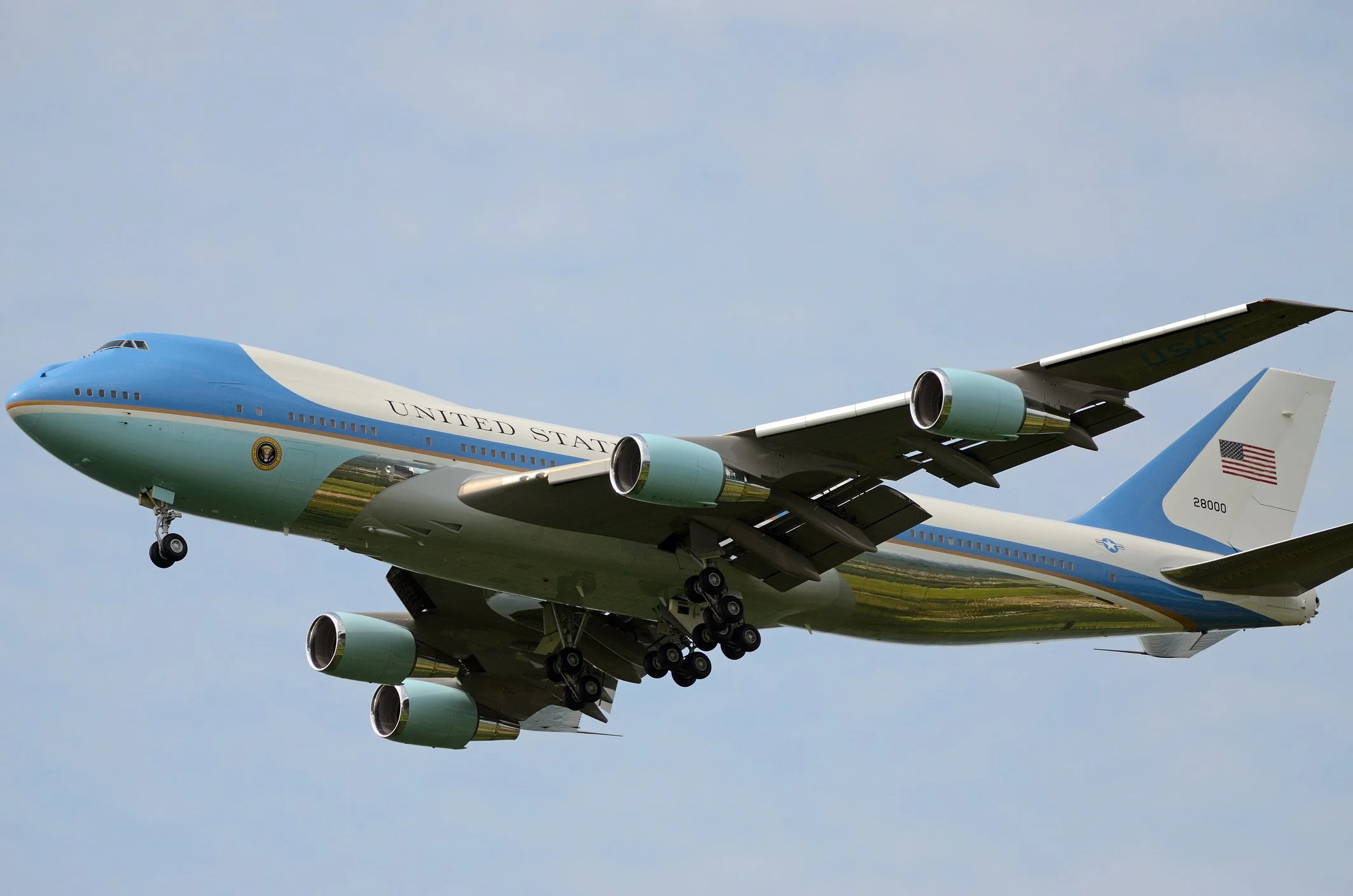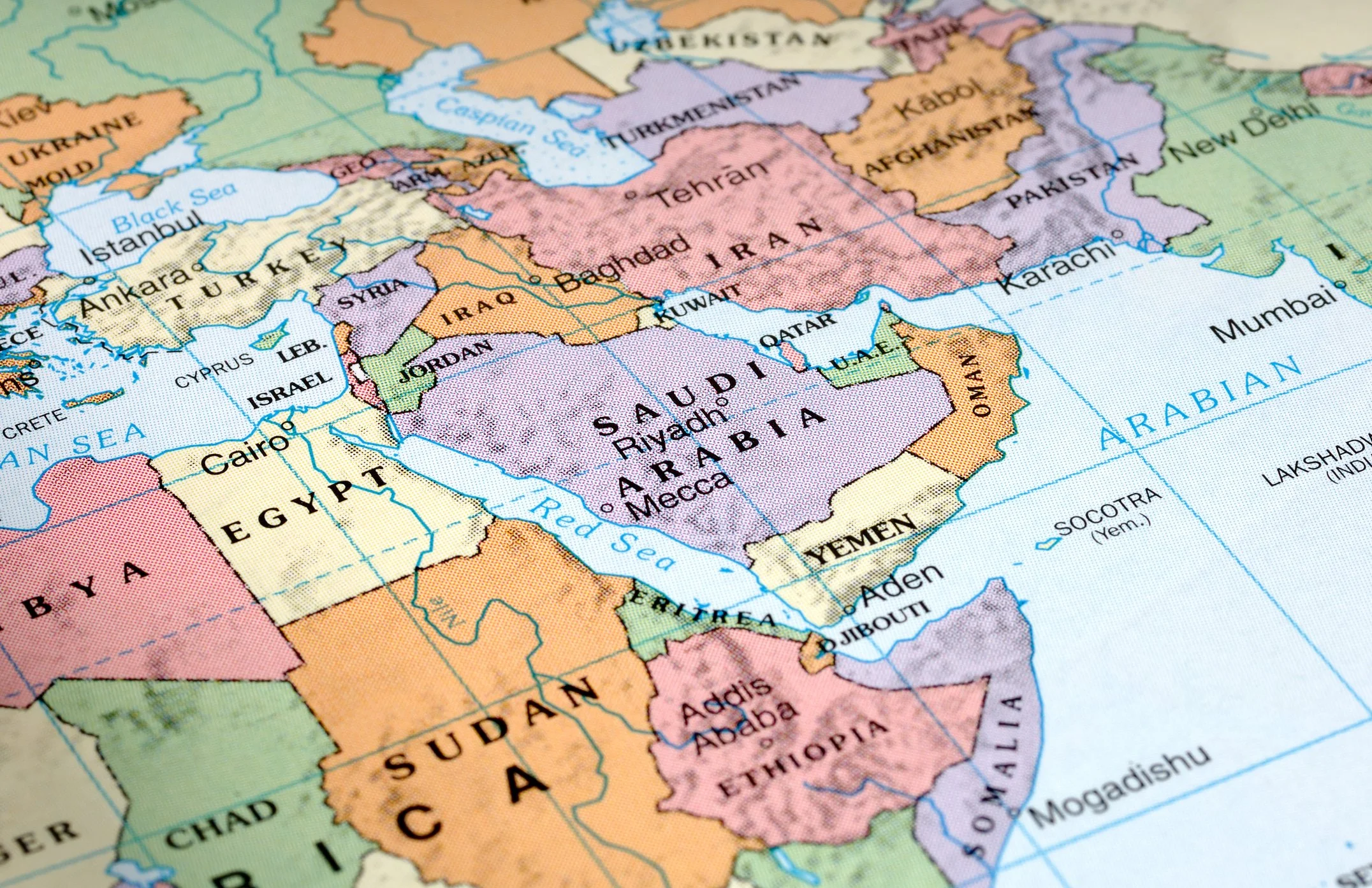Private Jet Travel in the Middle East
/While there are many notable private jets in the world, the most expensive is likely Air Force One, the aircraft carrying the President of the United States. Though the name is technically the call sign for whichever aircraft the President is flying at any given time, in practice, the term is currently used to refer to one of two heavily modified Boeing 747-200Bs.
Air Force One in flight. Photo Credit: BrianEKushner, iStock / Getty images plus
Each Air Force One option includes a conference room, a medical annex, a separate area for the media, two galleys and sophisticated communications equipment, among many other amenities. However, while the environment may be lavish, the aircraft themselves are aging – first commissioned during the presidency of Ronald Reagan, they are now almost four decades old. In 2009, the Air Force started the process of seeking replacements, with Boeing selected in 2015 as the chosen manufacturer.
In true government project fashion, the due date for the replacements has been rescheduled multiple times. By mid-2025, the delivery date was projected as 2029, with the Air Force mulling over modifications to accelerate the timing to 2027. Impatient with the delays, the Trump administration sought alternatives, and found one – a Boeing 747-8 owned by the Qatari royal family. While the original plan appeared to be the purchase of the aircraft, in May 2025, the Qataris announced plans to donate the jet to the U.S. Department of Defense instead.
Though the donation has been, shall we say, somewhat controversial, one inarguable element of this tale is its illustration of the role of private jets in the Middle East. While the new Air Force One is not the only jumbo jet owned by a non-airline party in the area, the region offers a wide variety of charter aircraft used by all sorts of people for all sorts of trips. If you’d like to know more about private jet travel in the Middle East, read on.
Not Near, Not Far
The term “Middle East,” though referring to a region documented back to the dawn of humanity, is only a bit more than a century old. Western Europe began using that phrase in the early 20th century (replacing the older “Near East”) to denote the geographical area encompassing most of the states in West Asia, plus Egypt and Turkey. While the name has been criticized as being Eurocentric, it is still generally accepted as a term describing a region spanning multiple continents (Africa, Asia and Europe).
Map of the middle East. Photo Credit: webking, istock / Getty images plus
Middle Eastern states include Bahrain, Cyprus, Egypt, Iran, Iraq, Israel, Jordan, Kuwait, Lebanon, Oman, the Palestinian territories, Qatar, Saudi Arabia, Syria, Turkey, the UAE and Yemen. Other countries that sometimes get lumped in include Afghanistan, Mauritania and Pakistan; the broader “Middle East and North Africa” (MENA) area incorporates the states of Maghreb and the Sudan.
From this region came the oldest known civilizations in the world, along with religions including Christianity, Islam and Judaism. The area was ruled by various regimes over centuries, culminating in the Ottoman Empire. However, the Ottomans picked the losing side in World War I, and the Allies partitioned the region after the war ended.
The modern era of the Middle East came with the growth of hydrocarbons in the global economy. Almost half of the world’s proven petroleum reserves are found in the Middle East, with the bulk resting in Saudi Arabia, the UAE, Iraq, Qatar and Kuwait. The start of large-scale oil production following World War II transformed the area in terms of infrastructure and influence, causing it to evolve from an underdeveloped region dominated by nomadic tribes to a modern entity with a great deal of influence on foreign affairs (as former U.S. President Jimmy Carter could attest).
Through the Arabian Skies
The first powered flight in the Middle East took place in 1909, when Baron Pierre de Caters of Belgium and Louis Blériot of France flew over Istanbul (now Constantinople) in Turkey. The first airline in the region, Egyptair, debuted in 1932, with Turkish Airlines following in 1933 and Saudi Arabian Airlines in 1945. The region became a transit hub for flights connecting Africa, Asia and Europe, often serving as fuel stops for long journeys spanning continents.
When air travel in the Middle East truly began to take off, however, it showed the same type of explosive growth that marked other infrastructure development in the region. In 2004, the region offered about 114 million airline seats per year, the seventh-largest market in the world. By 2024, that number had grown to more than 400 million.
Business aviation in the Middle East has not been immune to general aviation trends. As petroleum production in the U.S. and other parts of the globe peaked in the 1970s (at least for a time), the role of hydrocarbon-rich countries in the Middle East became more and more important. From 1970 to 1977, the GDP of Saudi Arabia increased by more than 1000%, with the UAE coming in second at 800% and Kuwait and Libya tying for third at 400%.
With wealth came the growth of high-net-worth individuals looking to fly private. The first fixed-base operator (FBO) in Saudi Arabia was established by Jet Aviation in 1979 – the first of many to come. The Middle East and North Africa Business Aviation Association (MEBAA), with a mission to “provide a platform for members of the business aviation industry in the MENA region,” was established in 2006 to support the industry and now hosts an industry show every two years.
“This is the area with unprecedented wealth in natural resources, particularly oil and gas,” says charter aviation consultant Paul Travis. “The result of that and the feudal nature of many of the countries that are in the area have resulted in what is probably one of the largest concentrations of executive jets in the world. It is an area that has the resources to invest on behalf of the state in executive air transportation in a way that Western countries would never consider.”
Comfort in the Skies
In terms of absolute size, the private jet travel market in the Middle East is still modest compared to that in North America, which represented about 2/3 of business aviation flights in the first half of 2025, and Europe, which made up another 15%. As with Africa, South America and Asia, the Middle East is typically lumped into the “Rest of World” category by entities such as business aviation data provider WINGX.
However, the post-COVID upswing in private jet travel has most definitely not passed over the Middle East. For example, in the period encompassing September 2023 to 2024, Turkey registered more than 28,000 business aviation departures – slightly more than double the number of that same period five years earlier. The UAE recorded almost 16,000 flights (an increase of more than 200% from five years prior) and Saudi Arabia just over 14,000 (an increase of almost 150%).
Private jet flying over dubai. Photo Credit: Franckreporter, istock / Getty images Plus
“Saudi Arabia is the biggest country in the region, but most people of any significance or wealth will tend to have their own airplanes and rarely use charter,” Travis says. “However, the UAE has got quite a vibrant charter market with a range of equipment, with the most active being in Dubai. Qatar Airways also has an executive charter division offered for service throughout the world.”
Many of those charter clients are looking for an ultra-comfortable experience – and one that can take them outside of the region if necessary. As per WINGX, the top five most-used business jets in the region last year included the Embraer Legacy 600/650, the Bombardier Challenger 600 series and the Gulfstream G300/G350/G400/G450 – all noted for being long-range.
“Overall, the Middle Eastern market is gravitating toward larger, more capable aircraft that elevate the travel experience,” Valdo Gomes, director of business development at Aviation Services Management, tells AV Buyer. “Demand is driven by a combination of comfort, range and technology.”
And, while the oil business and corporate activity in general are still major drivers of charter aviation use in the Middle East, that’s not the only force boosting demand. As per Euromonitor International, the region had three of the top 10 cities in international arrivals in 2024, with Istanbul coming in second only to Bangkok, Mecca placing at #5, and Dubai close behind at #7.
Tomb of the lion of Kuza, Al-Ula, Saudi Arabia. PHoto Credit: NMessana, istock / Getty images plus
Saudi Arabia is working hard to attract tourist dollars with its Saudi Vision 2030 initiative, seeking to diversify the country’s economy and transform its reputation. With attractions ranging from Al-Ula, with its archeological sites and natural landmarks, to NEOM, a large-scale development project looking to create a futuristic hub, the country wants visitors to think of it as a place for leisure and fun, not just black gold.
A Little Too Interesting
Of course, business aviation in the Middle East offers distinctive challenges. Some states (such as Lebanon, Libya and Syria) have been less stable than others. Various wars involving Iraq have led to a significant presence of U.S. military bases in the region. And, of course, there is the dynamic between the modern state of Israel, founded in 1948, and its regional neighbors. While relations among Israel and Arab nations appeared to be on the upswing with the Abraham Accords, signed in 2020, that trend came to a halt with the war between Hamas, which governs the Palestinian territories in the Gaza Strip, and Israel dating back to Hamas’s attack on Israel in October 2023.
“Israel presents a whole new set of complications,” Travis points out. ASOC, Israel’s aviation security organization, typically wants background details on all travelers flying into the country, whatever the aircraft, he says.
The conflict has extended to airspaces beyond Israel’s immediate proximity. In June 2025, Israel launched an air attack on military and nuclear facilities in Iran. Iran retaliated with missiles launched toward Israeli cities and military locations. The U.S. got involved with an airstrike targeting Iranian nuclear sites. Though a ceasefire was agreed to by the end of the month, the weeks of the conflict were still challenging for air operators. “When anyone starts flying missiles, Israel closes the airspace,” Travis says.
In September 2025, Israel launched an airstrike on Doha, Qatar’s capital, targeting various Hamas leadership figures it links to the October 2023 attacks. The uncertain outlook of the ongoing conflict between neighbors Israel and Gaza -- and the involvement, directly or otherwise, of surrounding states – will continue to pose a challenge for Middle East aviation in general, private jet travel most definitely included.
Soaring Into the Future
However, even age-old conflicts aren’t expected to keep the business aviation market in the Middle East from evolving. The demand from the energy industry isn’t going anywhere, and the draw of leisure activities ranging from sports tourism to water and theme parks is only expected to increase. As a result, the business jet market is expected to grow by more than 10% annually through 2029 in the region – with expansion likely to continue beyond that.
“Things can move at surprising speed,” Travis concludes. “It is a vibrant and ever-changing scenario, and the potential for tourism is enormous.”




